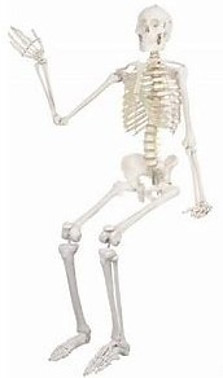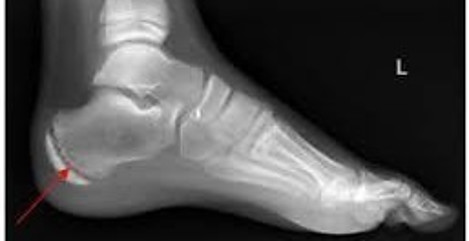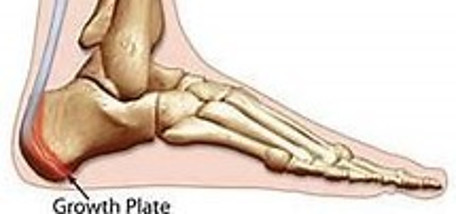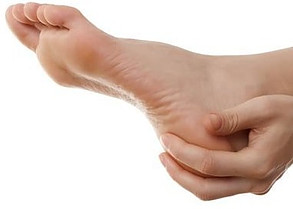You are here because you are wondering if either your child, or the child of someone you know, has a condition called Sever’s Disease.
Am I right?
With Sever’s Disease being the #1 cause of heel pain in children, it is IMPERATIVE that you read the information provided below so that you can determine exactly what is affecting your child’s game and treat it!
Sever’s Disease in children is NO JOKE, and here, I will detail (very simply) exactly what this impairing condition is in order for you to feel confident about what is impeding your child from excelling!
Let’s Talk About Bones
To fully understand Sever’s Disease (also known as Calcaneal Apophysitis), we must understand a little bit of basic knowledge surrounding bones in general.
We all have bones in our bodies… 206 to be exact!
Our bones have a purpose and that purpose is to form the shape of our bodies and allow us to move around.
Because we are tiny little things when we are brought into this world and eventually develop into adult-sized creatures over time, our bones MUST have the ability to expand with us. This massive expansion of our bones is made possible by something called growth plates.
Every single bone has a growth plate (also called the epiphysis) and they are exactly what they sound like… the area within a bone that allows the bone to grow.
Once a bone grows to its adult size, these growth plates close and become solid bone, but during growth (while the growth plate still exists), these areas are more fragile and are at greater risk for injury.
Enough about bones…
So… What is Sever’s Disease?
You reached this page due to a google search on “Sever’s Disease in children” or something similar. But… what is this condition really about?
You have probably figured out by now that it has something to do with bones and growth plates and you are correct!
Let’s discuss…
Sever’s Disease in children is definitely NOT a disease as it sounds but actually an injury.
The foot is comprised of 26 bones one of which is the heel bone (calcaneus). Look at the x-ray below of the adult foot… pay attention to the heel!

Guess what? The heel bone has a growth plate! This particular growth plate (in the heel) is called the Calcaneal Apophysis and is actually one of the first in the body to reach adult size and close.
Below is an x-ray of a child’s foot. See the growth plate on the heel?

Sit tight… this is where Sever’s Disease comes in!
Because the calcaneus (heel bone) grows faster than most other bones in the body, quite often the muscles and tendons that connect to it (and are growing also) just can’t keep up. When this occurs, the tendon attached to the back of the heel becomes very tight and pulls on the heel.

Couple this tightness of the tendon pulling on the heel around the area of the growth plate with added strain from sports or other strenuous activities and boom… you get Sever’s Disease in children!
So… in a nut shell, Sever’s Disease is when the growth plate of the heel bone becomes irritated and inflamed due to a tight tendon pulling on the area.
Is Age a Factor with Sever’s Disease in Children?
You can probably answer this question on your own by now, but YES… age is definitely a factor in determining the risk for  Sever’s Disease in children.
Sever’s Disease in children.
As stated above, Calcaneal Apophysitis (Sever’s Disease) has a direct correlation with puberty… when our bodies are growing their fastest.
So… because girls hit puberty first, we tend to see this condition diagnosed in them when they are around the ages of 8-13.
Boys, on the other hand, typically have later growth spurts and can be anywhere between the ages of 10-15 when and if they develop Sever’s Disease (which is much more common in boys vs. girls).
Typical Signs & Symptoms of Sever’s Disease
Do you still think that Sever’s Disease could be your child’s problem?
If your child is between the at-risk ages for their sex (noted above), is involved in extra-curricular activities that consist of running, pivoting, and jumping on hard surfaces, and has recently been complaining of heel pain, take a look at the common signs and symptoms associated with Sever’s Disease in children noted below to see if this condition could be the culprit.
- pain, mild redness, and/or swelling in one or both of the heels
- difficulty walking due to pain in one or both feet
- limping and/or walking on tiptoes in an attempt to lessen the pain felt with each step
- intensifying pain upon squeezing both sides of one or both heels
- pain in one or both heels that increases during an activity that involves running or jumping and improves upon rest
- complaints of a stiffness felt in the feet when first waking up in the mornings
Often times we see the development of Sever’s Disease in children that are beginning a new sport OR those who are starting a new season after a break from the sport.
Diagnosing Sever’s Disease in Children
If you are STILL pretty positive that your child is suffering from Sever’s Disease, what is your next step?
As expected, I ALWAYS recommend a visit to a podiatric physician (such as myself) or your child’s pediatrician for a verified diagnosis.
At your appointment, you can expect your physician to review your child’s medical history and discuss any changes in recent activity. In addition, your child’s doctor should perform a thorough medical examination of the feet and legs. Radiographs (x-rays) may also be performed to rule out any structural deficiencies or other conditions affecting your child’s foot.
That’s a Wrap
I hope that I have done a good job aiding in your understanding of Sever’s Disease in children… that was my goal (just in case you didn’t know).
The main take-away that I would like you to hold onto is that Sever’s Disease is the #1 cause of heel pain in children, not Plantar Fasciitis (which is the #1 cause of heel pain in adults).
Treatment options for Sever’s Disease do exist and you can read more about them in my article titled “How to Treat Heel Pain – Get Back in the Game“.
If your child is experiencing heel pain, it is essential to determine the cause in order for proper treatment to be implemented in a timely fashion. Hopefully, my article was able to either validate or eliminate Sever’s Disease as the culprit of your child’s pain.
To read about other causes of heel pain in children, CLICK HERE!
As always, I am here and willing to help you. If you have any questions, please feel free to drop a comment below and I will get back with you. In addition, myself (as well as my readers) would love for you to comment on any experience that you have had regarding Sever’s Disease below.
Your Online Foot Expert,
Dr. Misty
Podiatric Physician and Owner/Creator of FixUglyNails.com
What an informative information about bones, I have no idea that there is such a thing as growth plate. I do not know that it is an injury this is quite an interesting take on it. Is there a way to cure this injury? Can it be cure? I looked up on your other page it is just mostly focusing on pain management and it will be great to know how are we goin going to heal it. What will be the normal procedure?
Thank you for visiting my platform Nuttanee. I am glad that you found this article informative. In my article “How to Treat Heel Pain – Get Back in the Game” I do discuss the most effective ways to treat Sever’s Disease in children. The stretching exercises described there actually work to elongate and strengthen the tendons that are pulling on the heel bone. Once this tendon is elongated, this removes the pressure from its pull on the bone thereby eliminating the symptoms of the condition. Please just let me know if you have any additional questions. I am truly here to help!
Thanks for sharing this, Dr. Misty! This is such an educational post, I’ve never heard of the term Sever’s Disease in my life.
This is a very interesting read, even though I’m not a medical person and I know nothing about medical stuff, I found it very easy to understand this article, because you’ve explained everything very clearly and in a language that is so easy to understand.
Again thank you for sharing! Hope you can produce more quality content like this one! 🙂
Thank you Tim for the kind words. I do intentionally try to word my information in a manner to where anybody can understand it! I am glad that I was able to do this for you. Let me know if you ever have any questions!
Wow, now I better understand the probable cause of heel pain that some of my grandkids complain about when they are around. I must say I enjoyed reading through this post and it’s one that i wouldn’t mind reading over and over again. Aside from the fact that this bone grows and can cause pain to the individual, are there other factors that can cause pain on the heels of children?
Hello Chloe! There is a high probability that your grandchildren could definitely be suffering from Sever’s Disease. You may want to take a look at my article titled “How to Treat Heel Pain – Get Back in the Game” and implement these treatment modalities with them. Also, to answer your question, there are other conditions that can cause heel pain in children… Sever’s Disease is just the #1 cause. I discuss these conditions in my post titled “Heel Pain in Kids – Everything You NEED to Know“. Feel free to check that out as well. Just let me know if you have any questions. I am here to help!
Hello, Dr. Misty! I’ve never heard of Sever’s Disease, and as you stated, one would think it was a disease, just based on its name. You have shared that it isn’t a disease at all, but an injury. Odd how our English language can be so confusing sometimes. Interesting to me is the timing of the finding of the disease. It relates to puberty, etc. It makes total sense. My daughter is 8, so if she ever starts to complain of heel pain, I know to get her to a doctor. Thank you for researching this and presenting it in a simple way. I appreciate your knowledge! Blessings!
Good afternoon! I’m so glad that I helped you fully understand this condition. Hopefully your daughter will NOT become a victim of Sever’s, but if she does… you know where to come for help! Just let me know via commenting should you have any questions or concerns.
Thanks Doc. I actually don’t have a child with sever’s disease, but stumbled upon someone whose child did, and had a little interaction with them. Not fully understanding what they meant by sever’s disease lead me to this research.
I just wanted to be sure it isn’t something every parent should be worried about for their kids. Your article has definitely cleared my fears on that, and at the same time, I now have a vivid knowledge of what it is all about.
Thanks for sharing this with us.
Cheers..
I am so glad that I was able to clarify Sever’s Disease in children for you Queen. I am thrilled that you stumbled upon my article. This is a VERY common problem amongst our active youngsters and without the right treatment can be devastating. Should you (or your friend) have any questions, don’t hesitate to ask! ((:
Wow, thanks for this really education piece you have given here. I never knew there was any form of growth in the heel which is from a bone. I can remember clearly having these pain in my heel and making me walk on my toes. Reading through this post have helped me to understand more about this part of my body. However, during such pain, how do one treat it?
Good afternoon Dane! I am so glad that you found this information useful and I’m so sorry to hear that you had to deal with this pain as a child. I discuss the most effective treatment modalities for Sever’s Disease in my article titled “How to Treat Heel Pain – Get Back in the Game“. Feel free to check it out. Should you have any questions, just comment and I will get back with you. I am truly here to help!
I’m able to learn many new things from this review. I now know what growth plate means. I noticed that our feet stop growing at certain age. But I don’t know it is actually the first bone that stop growing before others. Now that I have known the risk of getting this sever’s diseases and the symptoms. The next thing is to know how it can be treated completely and how it can be avoided. Is it possible to reduce the excess growth of tendon inside this growth plate to avoid this injury? Thanksh for this enlightening review.
Hello Stella! Thank you for reading my article discussing Sever’s Disease in children. I am glad that I helped you to better understand the anatomy of our bodies. Most of the time Sever’s Disease is very manageable. I discuss the treatment for this condition in great detail on my post titled “How to Treat Heel Pain – Get Back into the Game“. This article will provide you with the additional information that you are wanting. Should you have any additional questions, please feel free to comment again and I will help you! Have a great afternoon!